Wildlife-proof hedge fences require seasonal maintenance to remain effective. In spring, prepare hedges for nesting season with selective pruning and native plantings. Summer calls for strategic pruning and organic deterrents to redirect foragers. Fall demands dense growth promotion and physical barriers before winter migration. Throughout winter, maintain structural integrity against harsh conditions. You’ll find native plants like blackthorn and hawthorn offer year-round protection while balancing beneficial and nuisance wildlife in your garden ecosystem.
Spring Setup: Preparing Hedges for Nesting Season Wildlife

While winter’s chill still lingers in the air, the early spring months offer the perfect window to prepare your hedge fences for the upcoming nesting season.
Begin by conducting a soil test to assess nutrient needs, then incorporate compost to boost fertility.
If you’re establishing new hedges, early spring is ideal for planting in colder regions. Choose a diverse mix of native species like blackthorn, hawthorn, and dogwood that provide both protection and food sources for wildlife. Adding plants like wild rose and honeysuckle will significantly enhance the shelter and food availability for various wildlife species.
Space plants properly to guarantee good air circulation and robust growth.
For existing hedges, prune selectively to create varied heights and densities that appeal to different nesting species.
Install bird boxes at appropriate heights and integrate your hedge with wider landscape features to create effective wildlife corridors.
Remember to water newly planted sections thoroughly during dry spells.
Summer Maintenance: Reinforcing Barriers Against Active Foragers
You’ll need strategic summer pruning to create denser hedges that naturally block wildlife access while maintaining healthy growth patterns.
Your defense against active summer foragers should include a combination of organic deterrents and physical barriers that won’t harm animals but will redirect their foraging elsewhere.
Installing heat-resistant mesh around vulnerable sections reinforces your hedge barriers without creating heat stress on plants during the hottest months.
Regular pruning using sharp, clean tools will encourage the dense growth that makes your living fence more effective as a wildlife barrier while maintaining its aesthetic appeal.
Pruning for Dense Protection
Summer’s abundance brings not only vigorous hedge growth but also increased wildlife foraging activity, making strategic pruning essential for maintaining effective barriers. Your pruning technique directly impacts how effective your hedge will be at deterring wildlife. Creating a fedge combination increases both wildlife protection and food production potential for your garden.
| Pruning Type | Timing | Benefits | Wildlife Protection |
|---|---|---|---|
| Formal | Early summer | Maintains dense shape | Creates impenetrable barriers |
| Informal | Mid-summer | Preserves natural look | Retains thorny branches |
| Selective | Late summer | Targets weak spots | Reinforces vulnerable areas |
| Renewal | Early fall | Removes damaged growth | Stimulates dense regrowth |
Using sharp, clean tools, remove up to one-third of old growth to stimulate dense new foliage. For mixed species hedges, adjust your approach for each plant type. Remember that proper pruning improves both hedge density and air circulation, reducing disease risk while creating wildlife-resistant living fences.
Deterring Summer Wildlife
As wildlife activity intensifies during the summer months, your garden barriers need reinforcement to withstand determined foragers. Conduct weekly fence inspections, looking for signs of digging or climbing, and repair any breaches immediately.
Maintain the structural integrity of your barriers by ensuring fences remain buried at least 12 inches deep and adding angled tops to prevent climbing animals. Consider integrating electric strands around your perimeter for enhanced protection against persistent rabbits and other small mammals.
Don’t neglect your living barriers—prune hedgerows to maintain density while managing vegetation around the base. Thorny species like Hawthorn and Osage Orange are particularly effective during this active season. Regular checks of hardware mesh are essential to ensure small animal prevention remains effective throughout the summer.
For thorough protection, combine physical barriers with natural hedges, creating a layered defense system that adapts to seasonal wildlife behavior patterns.
Heat-Resistant Mesh Installation
Heat-resistant mesh provides the next layer of protection for your garden during intense summer foraging activity. Choose aluminum or galvanized wire mesh with small weave openings to prevent both embers and small animals from penetrating your barriers.
Install mesh strategically around vents and openings, as these are primary entry points for wildlife. For maximum effectiveness, position your mesh at an angle to discourage climbing, and guarantee it extends at least 30 inches above ground and 10 inches below soil. On hillsides, you’ll need additional reinforcement for stability.
Select UV-resistant, flexible materials that can withstand temperature fluctuations and environmental impacts. Vinyl-coated hexagonal mesh offers excellent durability against weather and animal contact. Consider products like WDM 98 which provides flame-diffusing properties for enhanced protection during wildfire season.
Regular vegetation clearance around your mesh installation will maintain its effectiveness throughout the summer when wildlife foraging reaches its peak.
Fall Fortification: Securing Hedges Before Winter Migration
When wildlife begins preparing for winter migration, your hedges need extra protection to withstand both animal activity and harsh weather conditions.
Start by pruning strategically to promote dense growth that naturally deters animals. Apply a balanced fertilizer with high potassium about a month after the first frost to strengthen cell walls and boost cold resistance. Maintaining a slightly tapered shape when pruning ensures better sunlight penetration throughout your hedge, resulting in denser foliage barriers.
Create physical barriers using burlap screens to shield hedges from salt damage and harsh winds. Instead of salt, use sand or kitty litter for traction on icy paths near your hedges.
Don’t forget to deeply water hedges twice in fall—once mid-season and again before the ground freezes. Add a layer of organic mulch to suppress weeds and enrich the soil, ensuring your hedges have the resources to withstand winter visitors.
Winter Protection: Maintaining Hedge Integrity During Dormancy
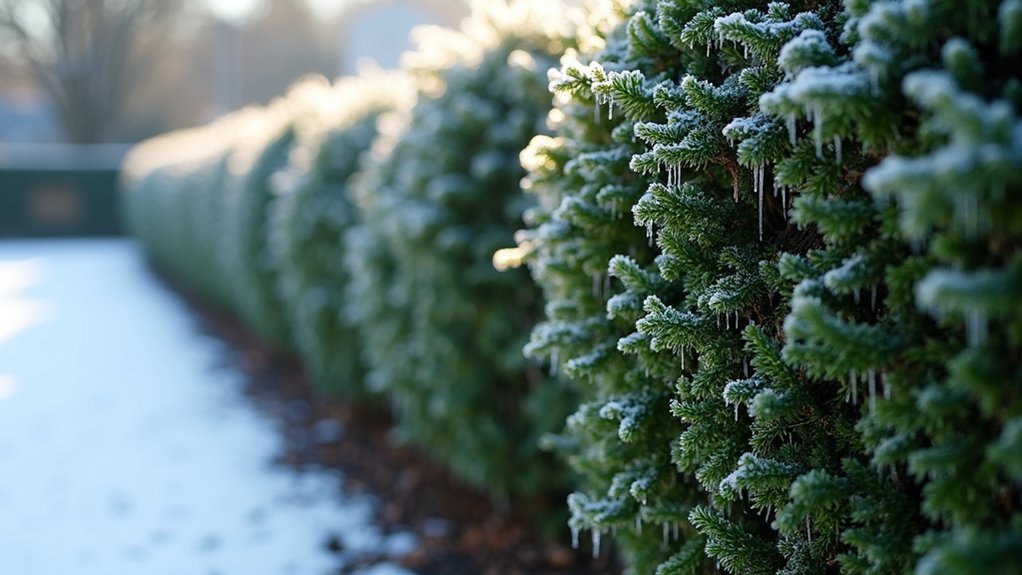
During winter dormancy, proper protection becomes essential for maintaining the structural integrity of your hedges against harsh elements. Apply burlap wraps to prevent branches from splaying under snow while ensuring adequate air circulation.
For thin-barked species, use commercial tree wraps or plastic guards for 2-5 winters of protection.
Deep water your hedges before ground freeze and firm soil regularly to eliminate air pockets caused by freeze-thaw cycles. Apply mulch to insulate roots and use high-potassium fertilizer in fall to strengthen cell walls. Minnesota’s harsh winter climate can cause severe damage to landscape plants, particularly hedges with exposed branches and foliage.
Erect burlap screens at least 12 inches from hedges to block wind and salt spray.
Remove snow gently without shaking branches, and monitor for rodent activity near bases. Apply breathable covers to shed snow load while avoiding moisture trapping plastic-only barriers.
Selecting Native Plants for Year-Round Wildlife Deterrence
Creating an effective wildlife-proof hedge begins with strategic selection of native plants that naturally discourage unwanted visitors throughout the seasons.
By combining plants with different deterrent properties, you’ll create a defense system that works in every season while supporting local ecology.
- Mix strongly-scented varieties like bayberry and spicebush with bitter-tasting plants to create multiple layers of protection
- Incorporate summer performers such as bee balm and anise hyssop whose fragrant leaves naturally repel browsers
- Add grasses like Little Bluestem that wildlife find unpalatable, especially during fall and winter
- Layer your hedge with dense-foliage plants that create visual barriers alongside plants with different growth patterns
- Rotate your plant selections annually to prevent wildlife from adapting to your landscape strategy
Consider including buttonbush, viburnum, and deciduous hollies in your hedge design as these plants are largely untouched by deer.
Strategic Mesh Placement for Seasonal Wildlife Patterns
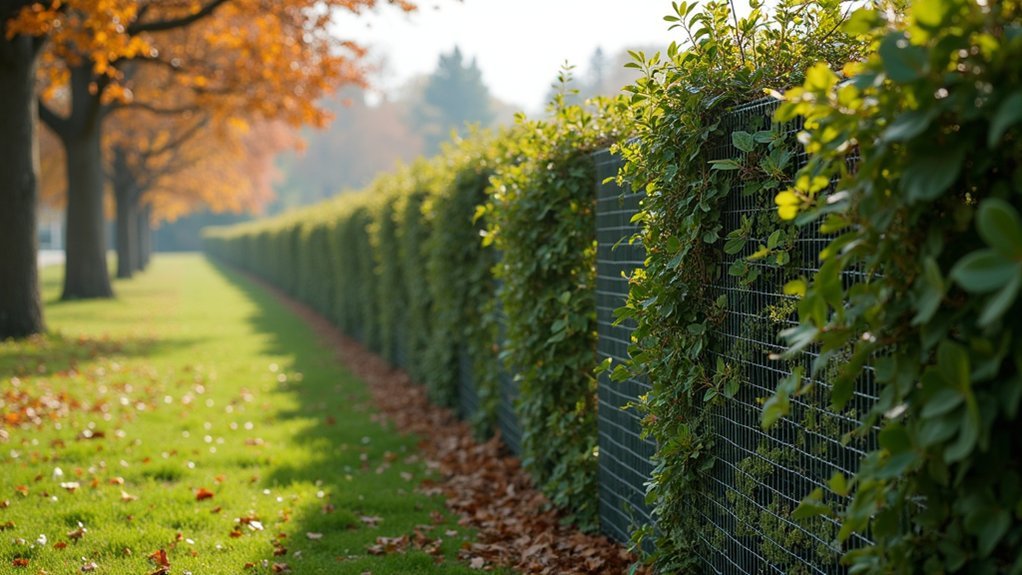
Strategic mesh placement must adapt to wildlife’s changing behaviors throughout the year, with higher reinforcements needed during spring migrations when animals actively seek new territories.
You’ll need to install deeper mesh extensions in summer to prevent determined animals from burrowing under your fence line when food sources become scarce. Utilizing high-tensile steel materials ensures your barriers can withstand persistent attempts by wildlife to breach your protective boundaries.
During winter, your fence requires additional reinforcement at snow-level points where wildlife pressure increases as food becomes limited and animals grow more desperate to access your property.
Spring Migration Solutions
As spring migration transforms the landscape with the return of various wildlife species, your mesh fencing strategy should adapt to these seasonal patterns.
Consider adjusting your barriers between early March and mid-June, with special attention to late April and early May when migration peaks in the western U.S.
- Install 3-inch or smaller mesh before late February to prevent early migrants like waterfowl from accessing sensitive areas.
- Increase fence height to at least 3 feet by early March when raptors begin their migration.
- Bury mesh 12-18 inches underground to deter burrowing animals active during spring thaw.
- Integrate native flowering vegetation with your barriers to provide alternative habitats.
- Temporarily adjust mesh placement around water features during late March when shorebirds arrive.
On particularly heavy migration nights when over a billion birds may be in flight, consider temporarily removing upper sections of mesh to prevent potential bird collisions.
Summer Burrowing Prevention
Summer brings a new set of challenges when wildlife intensifies its burrowing activities. To protect your property, install 2×3-inch galvanized or polymer-coated mesh with L-footers extending 12+ inches outward. White-coated wire improves visibility and prevents accidental collisions.
For maximum effectiveness, bury L-footers 10-12 inches deep, or extend them 2 feet down for persistent diggers like skunks and groundhogs. Proper installation enhances fence effectiveness against determined wildlife. Cover surface-level footers with mulch for stability and aesthetics.
After rainfall, inspect your fence for washouts that might compromise buried sections. Keep vegetation trimmed to eliminate shade that attracts heat-escaping animals.
For species-specific protection, adapt your approach: use 1-inch mesh for rabbits, while coyotes require 5-foot fences with angled tops and deep-buried barriers.
Winter Wildlife Pressure
Winter brings unique challenges to wildlife-proof fencing when migratory patterns shift and animals desperately seek food and shelter.
You’ll need to adapt your hedge fence strategy to accommodate these seasonal pressures while maintaining effective wildlife control.
- Choose high-visibility materials like white wire to prevent collisions with deer and swans in snowy landscapes.
- Install rounded rails rather than flat ones to shed snow effectively and maintain wildlife passages.
- Consider adjusting fence heights at known crossing points to redirect winter migration routes.
- Implement smaller mesh sizes in strategic locations while creating designated wildlife pathways.
- Position your mesh barriers away from waterways and steep terrain where animals concentrate during harsh conditions.
Addressing frost heave issues by installing posts below the frost line will prevent your wildlife barriers from becoming unstable during freeze-thaw cycles.
Regular inspection becomes essential during winter months as snow load and desperate animals can compromise even well-designed barriers.
Remember that wildlife pressure intensifies when food sources become scarce.
Balancing Beneficial and Nuisance Wildlife in Hedge Ecosystems
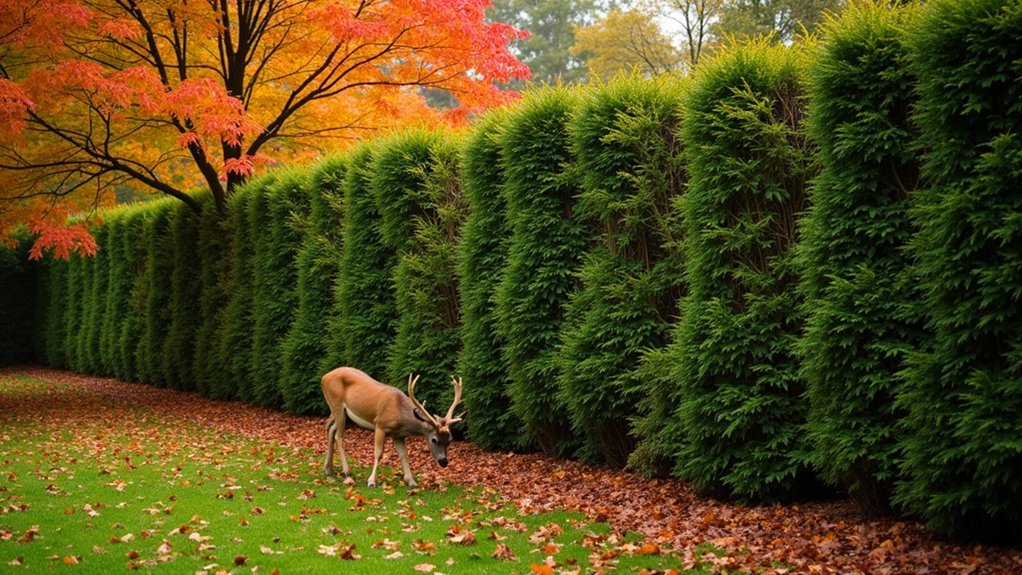
Creating an ecological balance in your hedgerow requires thoughtful planning and maintenance to maximize beneficial wildlife while minimizing nuisance species. By strategically selecting plant varieties and implementing adaptive management techniques, you’ll support natural predator-prey dynamics that maintain ecosystem health. Establishing hedgerows with a minimum width of 6 feet provides essential habitat space while still fitting in most residential landscapes.
| Wildlife Type | Benefits | Management Strategy |
|---|---|---|
| Pollinators | Crop fertilization, biodiversity | Plant hazel and flowering species |
| Birds | Pest control, seed dispersal | Maintain diverse shrub heights for nesting |
| Small mammals | Soil aeration, predator support | Create dense ground cover with selective gaps |
Include thorny shrubs as natural barriers while keeping hedgerows below six feet to reduce impacts on adjacent areas. The diversity of micro-habitats you create will attract beneficial insects that naturally control pest populations, creating a self-regulating ecosystem that benefits your property while contributing to local biodiversity.
Adapting Hedge Density for Changing Seasonal Pressures
Hedge density plays an essential role beyond just keeping wildlife at bay. By adjusting the thickness and structure of your hedgerows seasonally, you’ll create more resilient ecosystems that support beneficial wildlife while deterring pests.
Dense winter hedges provide vital shelter during harsh conditions, while strategic thinning in spring can open flight paths for pollinators. Properly designed hedgerows can significantly reduce soil erosion potential in surrounding agricultural areas.
- Prune during dormant seasons to avoid disrupting nesting wildlife
- Create wider hedges (over 20 feet) to maximize habitat potential year-round
- Mix deciduous and evergreen species for continuous shelter as seasons change
- Increase density in areas exposed to winter winds for better microclimate control
- Regularly monitor wildlife activity to guide your density management decisions
Natural Repellents and Companion Planting by Season
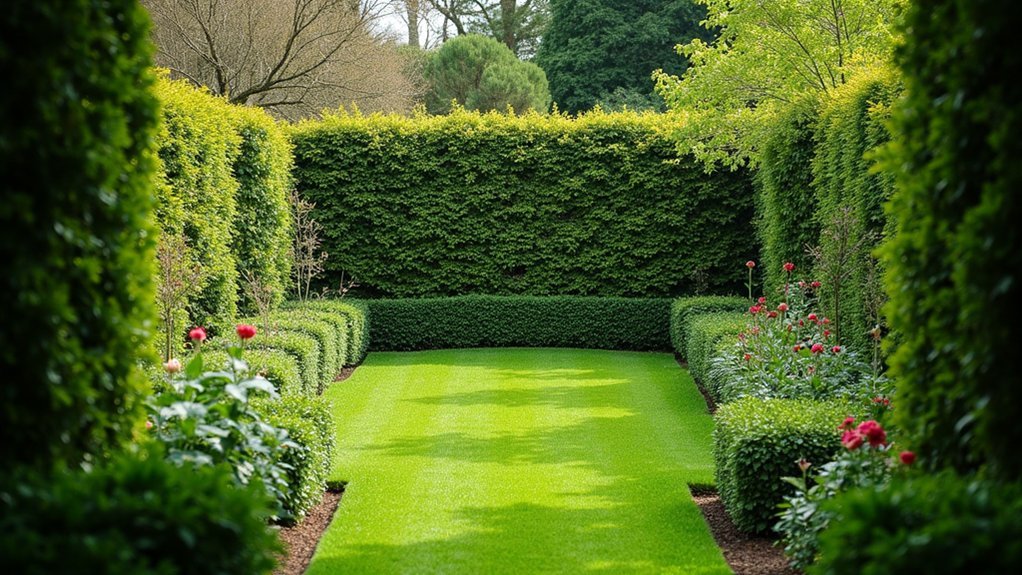
While commercial barriers offer physical protection, integrating natural repellents and strategic companion plants throughout the seasons creates multiple defense layers that adapt to changing wildlife behaviors.
Strategic layering of natural deterrents with physical barriers forms an adaptive defense that responds to wildlife’s seasonal patterns.
In spring, apply egg-based deterrents when deer target tender shoots, and plant lavender to mask desirable plants.
Switch to garlic or putrefied egg sprays during summer when natural forage diminishes, complemented by sage that releases pungent oils during heat waves. Consistent application of these repellents on a weekly schedule significantly improves their effectiveness against persistent deer.
Fall requires blood-based repellents during rutting season, reinforced with thorny prunings at hedge bases.
For winter protection, rotate to soap-based deterrents on dormant plants while incorporating evergreen aromatics like rosemary for year-round scent barriers.
Remember to rotate repellent types monthly to prevent habituation, and layer with mechanical barriers during seasonal shifts.
Economic Benefits of Seasonal Hedge Management vs. Traditional Fencing
Three major economic advantages make living hedge fences a superior investment compared to traditional fencing materials.
First, they typically require less initial investment while offering greater longevity—often lasting decades with proper maintenance.
Second, they provide ongoing economic opportunities through seasonal harvesting of materials for biofuels, berries, or other marketable products.
Third, hedgerows can potentially increase your property value through enhanced aesthetics and biodiversity.
- Lower long-term maintenance costs compared to replacing damaged traditional fencing
- Opportunity for carbon credit revenue in eligible regions
- Natural adaptation to environmental conditions reduces repair expenses
- Seasonal trimmings create valuable byproducts (mulch, biofuel, crafting materials)
- Increased pollinator presence benefits nearby gardens and agricultural activities
Frequently Asked Questions
How Does Soil Ph Affect Hedge Effectiveness Against Wildlife?
Soil pH impacts your hedge’s effectiveness against wildlife by affecting plant health. You’ll find ideal pH (6.0-7.0) produces denser, more robust hedges that create better physical barriers and support fewer pest infestations.
Can Wildlife-Proof Hedges Impact Property Value?
Yes, wildlife-proof hedges can boost your property value. You’ll see increased curb appeal, better security, and enhanced privacy. They’re attractive to buyers who value both aesthetics and practical protection from wildlife intrusions.
Are There Insurance Benefits to Installing Wildlife Barriers?
Yes, you’ll see insurance benefits from wildlife barriers, as they reduce damage risks and potentially decrease claims. Though coverage varies by policy, these preventive measures can lead to long-term savings despite upfront costs.
How Do Hedge Barriers Affect Neighborhood Wildlife Corridors?
Hedge barriers can disrupt wildlife corridors in your neighborhood, limiting animals’ movement between habitats. You’ll see reduced biodiversity as barriers fragment ecosystems, isolate populations, and restrict access to essential resources like food and water.
What Permits Are Needed for Wildlife-Proof Hedge Installation?
You’ll need permits from federal and state wildlife agencies if your hedge impacts protected species or habitats. Contact your local environmental department and U.S. Fish & Wildlife Service for specific requirements in your area.
In Summary
You’ll find year-round wildlife-proof hedging delivers both protection and ecological benefits when properly maintained. By adapting your approach seasonally, you’re creating a living barrier that responds to changing wildlife pressures while enhancing your property’s value. Don’t underestimate the importance of selecting native species and maintaining appropriate density. With consistent seasonal care, your hedge fence will outperform traditional fencing in both function and sustainability.

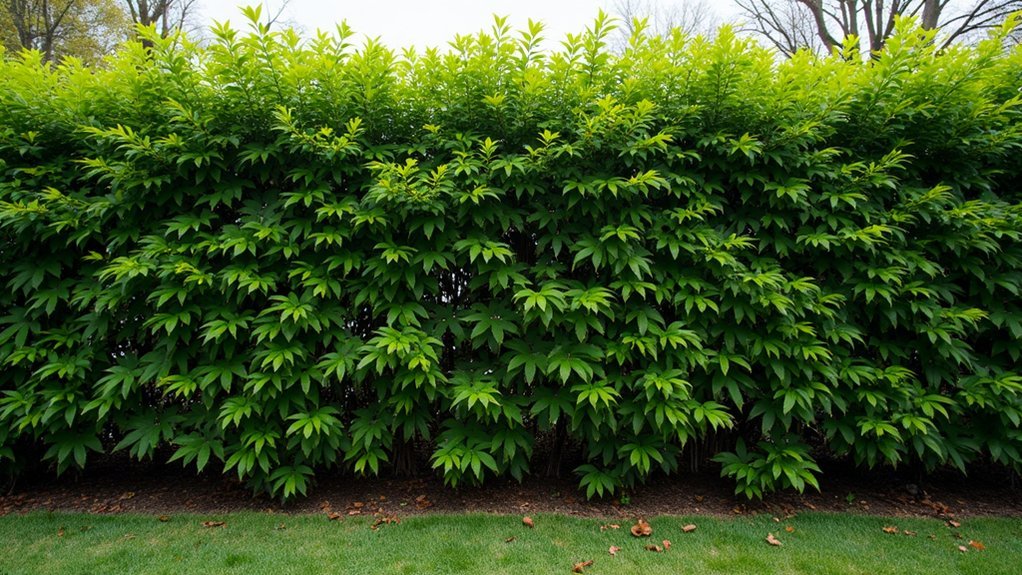



Leave a Reply